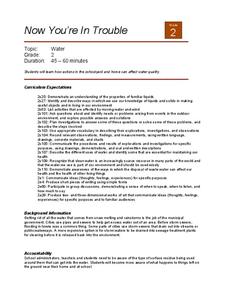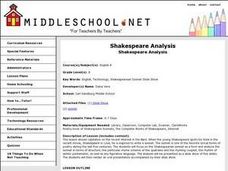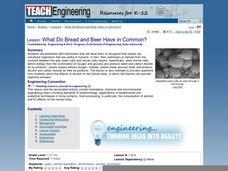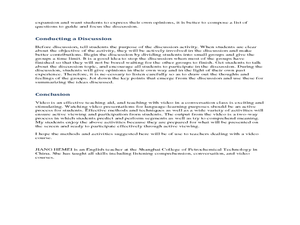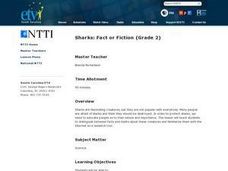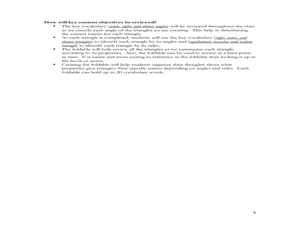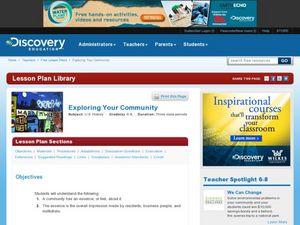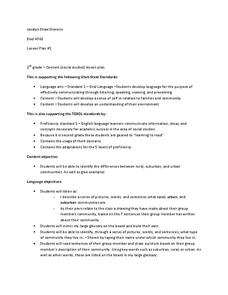Curated OER
50th Anniversary of Brown v. Board of Education
Students examine a poster of Brown v. Board of Education and discuss what the important details are. They read the story behind the poster and court case. They role play different sections of the case such as the court case or Linda...
Curated OER
The Sky is Falling!!
First graders complete a variety of activities about fall. They study a plant's life cycle and what happens to plants in the fall. They make leaf rubbings and discuss seed dispersal. They write a creative story about a seed and visit a...
Curated OER
Marine & Aquatic Habitats Activities - Tidal Pools
Students analyze the survival needs of different organisms and the conditions in a particular area that can affect these survival rates.
Curated OER
Now You're In Trouble
Second graders study how actions in the schoolyard and home can affect water quality. They discuss how rainwater can clean plants and sidewalks on its way to storm sewers. They draw an example of a simple maze that represents the maze...
Curated OER
Shakespeare Analysis
Eighth graders focus on the Shakespearian sonnet as a form and analyze the sonnet in terms of structure, the particular rhyme scheme of the quatrains and the rhyming couplet, the rhythm of iambic pentameter, as well as any figurative...
Curated OER
Sound Portraits
Students observe a variety of sounds which can be heard within their schoolyard habitat by sitting quietly by themselves for five minutes, listening, and then recording the sounds around them by drawing them.
Curated OER
What Do We Do With A Dirty Bomb?
Students examine composition of dirty bomb and its possible effects on a city, and investigate simulations of such an event; students use computational and problem solving skills to assess damage and prepare report proposing solution to...
Curated OER
What Do Bread and Beer Have in Common?
Students listen to an explanation of yeast cells and how they effect bread and beer. They discuss the ways alcohol affects the human body and participate in an indirect observation about cell respiration in yeast-molasses cultures.
Curated OER
Health and Nutrition
Students examine vocabulary words that deal with the parts of the body. They identify the body parts and organs associated with the five senses. They identify common illnesses, causes and treatments. They research various lifestyle...
Curated OER
Is Global Warming Happening?
Students investigate the probability of global warming and the effects of global warming on the environment. They conduct Internet research and collect data, transfer the data onto an Excel spreadsheet, and create a presentation that...
Curated OER
Renewing a Contract with HBC
Students are invited to use the ECO Exploration, the Fur Trade and Hudson's Bay Company, as well as other sources identified, to complete a table (see Student Handout) of words and phrases that describe the duties, responsibilities and...
Curated OER
Respect for Self and Others-Giving and Getting the Big R
Seventh graders work in groups of three. They plan scenarios in which they demonstrate inappropriate and appropriate interpersonal skills in a variety of social situations. Students assume the roles of the individuals in their scenario...
Curated OER
Develop An Individual Career Plan
Students research, investigate and develop an individual career plan. They analyze all their career options and goals. Each student fine tunes their interviewing and written skills as they prepare to seek certain jobs out in the work force.
Curated OER
ESL Storyboards
In this ESL literacy worksheet, learners examine each individual board and then use them to tell and write a story about the events.
Curated OER
Homeless in our Community
Third graders explore homelessness in their local community. In this service project/social studies lessons, children research local areas where homeless people reside, discuss global acceptance and unity, and visit a local food bank.
Curated OER
Town Mouse/ Country Mouse
Students recognize the difference between the city and the country. In this City Mouse, Country Mouse lesson, students listen to a story and describe and map differences between the city and the country. Students understand that people...
Curated OER
Book Trailers
Students develop a list of criteria for a book trailer. In this book trailer lesson, students review book trailers, create storyboards and use Photo Story 3 to create book trailers. Students create a mini-webquest to review copyrights.
Curated OER
Teaching with Video in an English Class
Students participate in a video English class. For this video lesson, students read a play then video activities they do to better understand the play. Students video themselves answering questions about the play then listen to the...
Curated OER
Sharks: Fact or Fiction
Second graders discover the truth about sharks. In this shark lesson, 2nd graders use different resources to help distinguish between fact and fiction with what they have heard about sharks. They complete an attached activity sheet.
Curated OER
The Parts of a Tree
Students create a tree model. In this parts of a tree lesson, students read A Tree is a Plant, then discuss what trees are used for. Students use various materials to build and label their own tree.
Curated OER
Angles in Triangles
Eighth graders translate word problems using mathematical ideas. For this geometry lesson, 8th graders identify angles of triangles using equations and the triangle sum theorem. They create angles with a protractor and straight edge.
Curated OER
Exploring Your Community
Students showcase their community. In this multimedia lesson plan, students discuss what makes their community special and then create videos that highlight the features of the community.
Curated OER
What is a Community?
Second graders write sentences in a graphic organizer about communities and what they include. In this community lesson, 2nd graders will also draw a picture based on their description.
Curated OER
One Story, Many Tales
Students compare and contrast Cinderella stories. In this folktale lesson, students discuss the attributes of the genre and then read and research different cultural versions of the tale. Students present their findings to their classmates.





